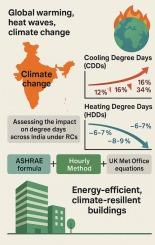印度极端代表性浓度路径(rcp)情景下的学位日动态
IF 7.1
2区 工程技术
Q1 CONSTRUCTION & BUILDING TECHNOLOGY
引用次数: 0
摘要
全球变暖、热浪和气候变化是人类关注的重大问题,因为它们对生态系统和生活环境构成潜在威胁。气候变化对气温日数的影响很大,直接关系到人类的热舒适和建筑物的能源使用。本研究利用1990年至2014年的典型气象年(TMY)数据,评估了在不同代表性浓度路径(rcp)情景下,气候变化对印度各地加热度日(hdd)和冷却度日(cdd)的影响。为了确保比较分析,我们使用了三种方法来计算度日:ASHRAE公式、小时法和英国气象局(UKMO)方程。研究结果表明,由于温度升高,cdd显著增加,这表明对冷却的需求不断增加。具体来说,到2030年,cdd预计将增长12%,到2050年将增长16%,到本世纪末将增长32.5%至34%。相反,到2030年,硬盘需求将减少约6 - 7%,到2050年将减少8 - 9%,到2100年将减少17 - 19%。由于印度尚未建设大部分基础设施,因此必须将气候变化纳入建设规划、设计和开发中。这将确保未来的建筑节能、适应气候,并能在气温上升和天气变化的情况下提供热舒适。本文章由计算机程序翻译,如有差异,请以英文原文为准。

Degree days dynamics under extreme representative concentration pathways (RCPs) scenarios in the Indian context
Global warming, heat waves, and climate change are significant concerns for humanity due to their potential threat to ecosystems and living environments. Climate change substantially affects degree days, directly related to human thermal comfort and energy usage in buildings. This research assesses the impact of climate change on Heating Degree Days (HDDs) and Cooling Degree Days (CDDs) across India under different Representative Concentration Pathways (RCPs) scenarios using Typical Meteorological Year (TMY) data from 1990 to 2014. To ensure comparative analysis, three methods were used to compute degree days: the ASHRAE formula, the Hourly Method, and the UK Met Office (UKMO) equations. Findings indicate a significant rise in CDDs due to increasing temperatures, suggesting growing demand for cooling. Specifically, CDDs are expected to surge 12 % by 2030, 16 % by 2050, and 32.5 to 34 % by the end of the century. Conversely, HDD demand is reduced by about 6–7 % in 2030, 8–9 % in 2050, and 17–19 % by 2100. As India has yet to construct most of its infrastructure, climate change must be included in construction planning, design, and development. This will ensure that future buildings are energy-efficient, climate-resilient, and can provide thermal comfort in rising temperatures and changing weather.
求助全文
通过发布文献求助,成功后即可免费获取论文全文。
去求助
来源期刊

Energy and Buildings
工程技术-工程:土木
CiteScore
12.70
自引率
11.90%
发文量
863
审稿时长
38 days
期刊介绍:
An international journal devoted to investigations of energy use and efficiency in buildings
Energy and Buildings is an international journal publishing articles with explicit links to energy use in buildings. The aim is to present new research results, and new proven practice aimed at reducing the energy needs of a building and improving indoor environment quality.
 求助内容:
求助内容: 应助结果提醒方式:
应助结果提醒方式:


